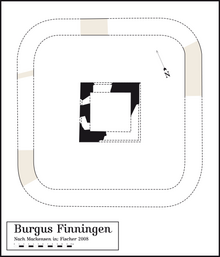








Aburgus (Latin, plural burgi ) or turris ("tower")[1] is a small, tower-like fort of the Late Antiquity, which was sometimes protected by an outwork and surrounding ditches. Darvill defines it as "a small fortified position or watch-tower usually controlling a main routeway."[2]
Burgus was a term used in the later period of the Roman Empire, and particularly in the Germanic provinces.[3]
Burgus is a Latin word, used from the end of the second century[4] but more common in late antiquity, and derived from the Germanic languages; it is cognate with the Greek pyrgos. It refers to a fortified tower, sometimes designed for observation.[5]
From 369 AD, under Valentinian, an extensive fortress building programme was set under way on the borders of the Empire. This entailed the construction of two-storey, rectangular towers (on average 8–12 m wide and 10–12 m high), so-called residual forts (German: Restkastelle) in limes camps that had already been largely denuded of their complements, and granaries (horrea) envisaged for border troops. These burgi were essentially a development of the limes towers of the middle imperial period and consisted, in the case of the larger examples, of a tower-like central structure and outer fortifications (arampart, defensive wallorpalisade, surrounded by several ditches). A conspicuous feature of buildings of this type of the Late Antiquity is the significant increase in size of the central tower. Most of these new fortifications were abandoned or destroyed by about the middle of the 5th century.
Burgi were erected along border rivers and along major roads, where they are likely to have been used for observation, as forward positions or for signalling. Buildings such as smaller watchtowers, fortlets (castella), civilian refuges at estates and fortified docks for riverboats, especially on the Upper Rhine and Danube, were also called burgi. In the coastal cities of the Roman Empire and early Byzantium, local defensive complexes (burgi) were also built to protect important harbours.
Troops at these posts carried out policing duties on the roads and looked after the maintenance of law and order in the villages.[6] Burgi might control movement on roads or rivers, or serve in emergencies as a places of retreat. Larger towers, such as one at Asperden, probably served as refuges for the surrounding population and as granaries.
A special type of burgus contained a river landing. In addition to a rectangular building near the river bank, these had crenellated walls that extended up to or into the river like pincers, thus protecting a landing stage or berthing bay for cargo ships and river patrol boats.